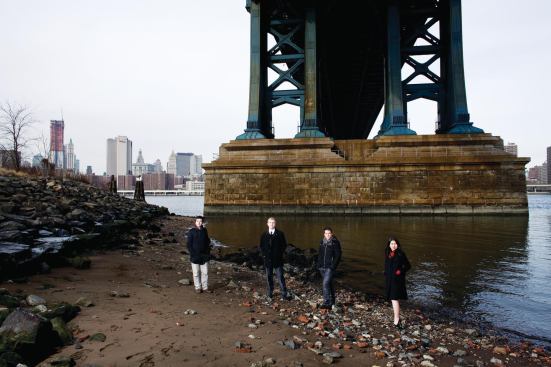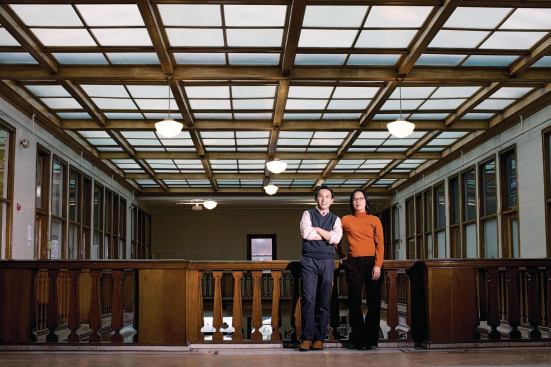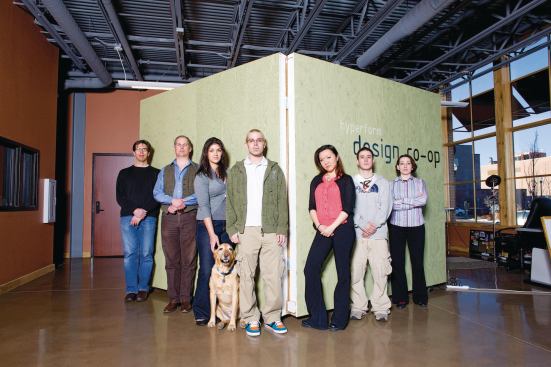Noah Kalina
PRELocation: New York and Providence, R.I. Partners: From left:…
Now is a time when a lot of young architects are striking out on their own. Admittedly, this could be said of any period in the past 50 years: Businesses launched from a partner’s basement or with a loan from Uncle Stan have become the stuff of cliché. But recessions tend to accelerate the formation of new firms. “More new firms start in a period of recession than at any other time,” says management consultant Peter Piven.
Generation X and Y architects may be more willing—and better equipped—to start their own practices than their predecessors were. Two factors seem to be propelling them into entrepreneurship: The first (no surprise) is the Great Recession, which has made architectural internships and associate positions at established firms extremely scarce. Back in the 1990s, laid-off architects could set off on an alternative career path—they might join a tech company, for example. “The problem is, this recession is deeper and broader than the last time, so those opportunities aren’t as prevalent,” Piven says. Unable to find employment even outside the profession, many of today’s young architects figure they might as well chase clients instead of job leads.
The other factor is improved technology. An architect in Seattle can share CAD documents with her partner in Atlanta; Skype calls can replace many in-person meetings, and they cost far less than a plane ticket to see a client in Mexico City or Seoul. High-speed wireless Internet at home can obviate the need for dedicated office space (if you’ve got a staff of one or two).
So while the phenomenon of young architects taking the leap is nothing new, there never have been fewer barriers to launching a practice (except, perhaps, the erosion of credit over the past couple of years—which might explain the blossoming of various low-to-no-overhead business models). In the pages that follow, ARCHITECT spotlights three emerging firms around the country. They may differ with regard to experience, goals, and design sensibility, but all are gutsy and creative enough to reassure us that American architecture will continue to thrive post-downturn. How could it be otherwise?
XChange Architects
Brookline, Mass., and San Francisco
In September 2008, Derrick Choi turned on the TV in his hotel room near Schiphol Airport in Amsterdam and learned that the investment bank Lehman Brothers had just collapsed. Foggy from air travel—he was shuttling back and forth between Amsterdam and Abu Dhabi at the time—he didn’t grasp the full import of the news. “The global recession was a nebulous concept,” he says now. If his head had been clearer, he might have panicked: He had launched his own business a few months earlier.
A year and a half later, there’s no need for panic. XChange Architects has grown from one person to “an army of three,” Choi, 35, jokes. Jonace Bascon, 36, a former classmate of Choi’s at Harvard’s Graduate School of Design (GSD), leads the firm’s San Francisco studio, which has a focus on higher education. Lynn Hsu, 36—previously of Kyu Sung Woo Architects and also a GSD alum—works with Choi in their Brookline, Mass., studio. Bascon and Choi are both principal architects; Hsu is a senior consulting architect, a role that appealed to her when she decided to re-enter the workforce after a stint at home with her twin sons. “I was interested in trying something different, a little more flexible,” she says. At XChange, she can take on side projects and largely set her own hours: “It’s not the set 9-to-5 thing anymore.”
The firm’s breakout project was planning and feasibility work for Abu Dhabi International Airport. “We were given the design lead on a 250,000-square-foot arrivals hall and administrative facility,” Choi says; the project is scheduled to start construction later this year. But XChange is proving to be admirably nimble, tackling not just transportation and infrastructure projects—these are Choi’s special interest, dating back to his summer intern days at Skidmore, Owings & Merrill and continuing through his more recent stint as a project director at AECOM—but also a Talmudic study center, for the Kollel of Greater Boston (with Jacobson Spear Architecture), and a retractable sidewalk café system, for Allston Village Main Streets. The latter project, now in development, received a design excellence award from the Boston Society of Architects in 2009.
Even this early in the firm’s life, Choi has formulated some rules to prosper by. First, freeware and filesharing can be your best friends. “We have found that it costs virtually nothing, other than an AutoCAD license, to be very competitive,” he says. XChange primarily uses SketchUp for renderings, and team members share files via dropbox.com, essentially a free FTP site. Skype has been “incredibly functional” for conference calls—“a hundred times cheaper than other WebEx options that were all the rage about two years ago,” Choi remarks. Still, he admits that there is some risk involved when you rely on free tools alone—which is why XChange backs up files every day on a portable remote drive.
Against the advice of many a management consultant, XChange enters competitions regularly. “[In summer 2009] we started winning competitions; this is, ironically, becoming a key source of sustenance,” Choi says. “We’re getting … into some public work through community-based competitions and other charrettes, and getting [our] name out there on a pro bono basis.”
Seeking out partnerships is another important strategy. Although Choi felt ambivalent about it, XChange pursued and received designation as a minority and disadvantaged business enterprise (MBE and DBE) in the city of Boston and the Commonwealth of Massachusetts. Choi is glad they went through with it, because many transportation projects are awarded by agencies with a minority participation target. XChange is also aiming for federal work by pursuing the Small Business Administration’s 8(a) business development certification for small, low-net-worth businesses.
So now the huge A/E firms come knocking in hopes of partnering up. “I do have a lot of big A-and-E’s reaching out to me, saying, ‘We couldn’t have found a better arrangement,’?” Choi says. “Reconnecting with [them] has really made a difference for us.”
PRE-Office
New York and Providence, R.I.
Last spring, four Columbia University M.Arch. students got together over a few bottles of sake and started talking. They had recently returned from a studio trip to Asia and decided they’d like to start a practice together. Or, if not a practice, some kind of common architectural venture. They weren’t exactly sure.
They thought it would be a good idea to ask the established architects they knew to recount their own experiences and offer suggestions on how to start a firm. As they interviewed more architects, they realized the discussions would hold interest for a much wider audience—all the other young designers who were trying to find their way in a terrible economy. “A lot of the experience [touched on in the interviews] is typically something someone would learn on the job, but those job opportunities don’t exist,” says Leah Meisterlin, one of the foursome.
So out of the interviews came a book project, Conversations with Architects, as well as a proto-practice: PRE-Office. Meisterlin, 29, is a partner, along with Zachary Colbert, 28; Aaron Davis, 27; and Daniel Kidd, 28. Davis lives in Providence, R.I., and the others live in New York. In order to bridge the distance, “we use the Google suite of free networking/office tools a lot and have weekly videoconferences via webcams,” Davis explains.
To call PRE-Office a firm is not quite accurate. The partners idealistically describe it as a collaborative and emphasize that they bring different interests to the table, although they share the same restless, inventive approach to practice. “We are passionate about space and believe in a certain ‘rearguard’ position of practice,” Davis says. Meisterlin says the common ground the partners occupy is “a commitment to not necessarily knowing what practice is at any given time, but constantly trying to figure that out.” (Which explains the name.)
PRE-Office doesn’t have a physical office, although that might change. “We have potential projects on the horizon; if they [come] through, we’ll need an office,” Meisterlin says. Its only overhead so far is its website. All four partners have day jobs or freelance projects (or both), but hope to make PRE-Office their full-time focus. “We’re working on things that will bring in money eventually,” Meisterlin says. “Because we’re new, we only recently got our act together about the legal stuff.” (They bartered design work for legal services.) The business just received its first check—not bad, considering the partners finished graduate school in May.
PRE-Office is talking to publishers about Conversations with Architects and expects that the book—potentially the first volume of a series—will be published fairly soon. Its next initiative is Spontaneous Architecture, a design competition that erases some of the usual hurdles to participation, i.e., man-hours and money. Spontaneous Architecture charges a $5 entry fee and asks entrants for a single image with 100 or fewer words of text. People from four continents signed up for the inaugural contest.
With so many other commitments—Colbert teaches at Columbia and works for Bernard Tschumi Architects; Davis teaches at the Rhode Island School of Design; Kidd does consulting work and taught at Columbia last semester; and Meisterlin is a map designer and researcher—how do they keep the collaboration going? “Sheer will,” Meisterlin says. Davis notes that their open-source mode of working helps: “It allows us to work at all hours of the night without necessarily needing to leave our apartments.”
[Editor’s Note: In the print edition, the firm name was given as PRE. We have amended it to PRE-Office for the online version of the article, in accordance with the company’s legally registered name.]
Hyperform Design Co-op
Arvada, Colo.
In late 2008, Carrie Momeni started getting together with fellow out-of-work designers in the Denver area. She had met Tim Geisler through a mutual friend; every Tuesday, she and four or five other people would gather in Geisler’s house for coffee and commiseration. Before long, they started to discuss theoretical projects. They came to believe, Eric Anderson recalls, that “perhaps it would be easier to pursue clients of our own instead of knocking on doors that wouldn’t open.”
When an education project came their way—through luck and a contact of Geisler’s—they mobilized to claim it. Hyperform Design Co-op was born.
Geisler, 42, found a studio space in a building in Arvada, about seven miles from downtown Denver. The building is owned by a longtime acquaintance of his, engineer Joe Jehn; the building also houses Jehn’s engineering company. Hyperform agreed to provide design services to Jehn in lieu of rent. The designers moved in and built desks and a room divider on wheels, mainly out of salvaged materials; they duct-taped together squares of carpet samples for flooring.
The co-op now has about 50 members, Geisler estimates, with “about 10 people who are involved on a daily basis.” Membership is free, and members include architects, landscape architects, interior designers, industrial designers, and graphic designers. Hyperform’s “three pillars,” as Geisler calls them, are that it’s a nonprofit entity; that the directors—currently Geisler, Anderson, and Momeni—are unpaid; and that it’s an open forum, which means that members can’t use information gained at the co-op to tilt the playing field in a competitive situation.
Although the co-op tag might conjure an image of granola and Birkenstocks, Anderson, 48, cites one very mainstream inspiration: New York’s design-focused temp agencies, which allow small firms to hire an extra person for a month or two. “For us, it’s an old idea that hasn’t really been utilized here in Denver,” he says.
Most members have their own business entities or side jobs but can jump into a co-op project if the opportunity is there (so far, a parochial school in Texas is the co-op’s only significant project). Momeni, 30, who plans to sit for her ARE exams at the end of the year, teaches yoga part-time and picks up odd jobs, “whatever people need help with. I need to pay my bills.” She doesn’t get a regular salary—like other members, she takes a cut of project fees—but she would rather work this way than have to leave the profession. Geisler has his own firm, and the Texas project is insured through it—umbrella insurance for the co-op “gets very complicated,” Anderson says, so for the moment, members take legal responsibility for the projects they bring in.
At press time, Anderson was gunning for another project, a charter school in Denver. The credentials of another member are crucial for the bid. “We can really pull from people’s experience in different project types,” notes Anderson, an advantage over narrowly specialized firms. Whatever happens, the directors have reinvested enough revenues to keep operating through 2010.
“Any member can come and share our resources here, and have a collegial environment in which to work. The whole thing is about enabling people,” Geisler says.
Member Amy Burke, an architectural designer, likes having a place where she can network, attend educational events, and use reference materials like code books: “It sort of operates like a firm, without all of the overhead that comes with a firm.”


